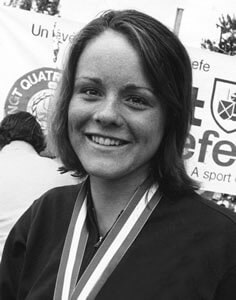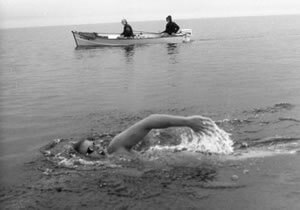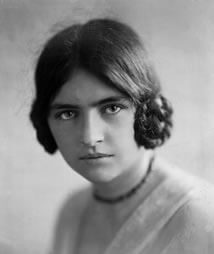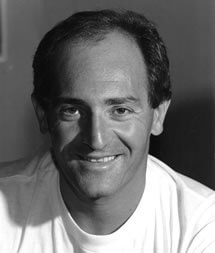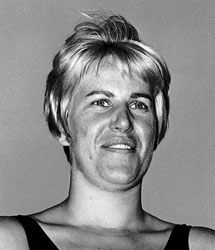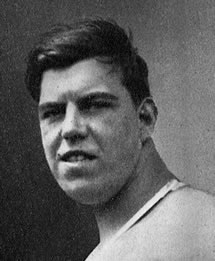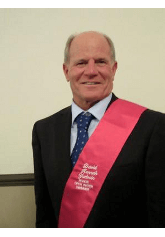ISHOF Class of 2014 Revisited – The Year of the Open Water Swimmer
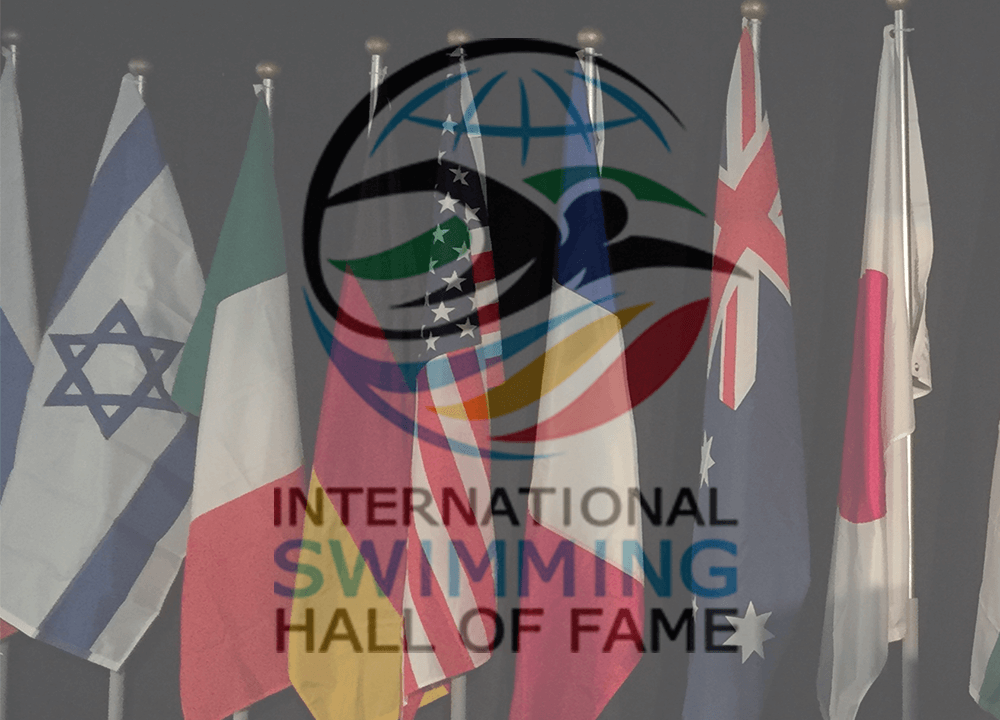
Because of the Covid-19 Pandemic and the postponement of the International Swimming Hall of Fame Induction Class of 2020, ISHOF will be reliving some of their previous induction classes. This week we revisit the ISHOF Class of 2014. That year a total of twenty honorees were inducted; seven of which were open water swimmers. In addition to the seven open water swimmers, there were three pool swimmers, Grant Hackett (AUS), Agnes Kovacs (HUN), Tom Malchow (USA), one diver, Peng Bo (CHN), two synchronized swimmers, Penny and Vicky Vilagos, (CAN), two water polo players, one male and one female, Carlo Silipo (ITA), and Karen Kuipers (NED), two coaches, one male and one female, Joseph Nagy (HUN, USA, CAN, ESP)(Swimming) and Charlotte Davis (USA) (Synchronized Swimming), and two Honor Contributors, Dale Petranech (USA) and Norman Sarsfield (GBR)
We start our series by showcasing our Open Water Honorees with the content and biographies that were presented in 2014…
OPEN WATER SWIMMERS:
SANDRA BUCHA (USA)
FOR THE RECORD: PROFESSIONAL MARATHON SWIMMING ASSOCIATION WORLD RANKING: 1973 (4th place), 1974 (2nd place); CHICAGO LAKE FRONT RACE: First Place (1973, 1974, 1975); LA TOQUE 24 HOUR RACE: First Place (1974, 1975); LAC ST. JEAN RACE: First Place (1974, 1975); LAVAL, CANADA RACE: First Place; ONE AMERICAN RECORD: 200m freestyle, S.C.M.
Like Annette Kellerman before her, this little girl earned her place in swimming history in the water and in the courtroom.
Sandra “Sandy” Bucha, had been a top age-grouper in Washington D.C. before her family moved to Illinois. Swimming under coach Don Watson, in Hinsdale, she became an American record holder and national champion. She trained with the boy’s high school team, as there were no high school swim teams for girls in the state of Illinois in the 1960’s; Before her senior year, with the support of her coach and parents, she filed suit against the Illinois High School Association to allow her to compete as a member of the boys team. Although she lost the suit, this was before the passage of the Title IX Amendments to the Civil Rights Act the famous battle of the sexes. It was a sign of things to come.
Returning home in the summer of 1973, Sandra saw an ad for a 10-mile lake swim in Lake Michigan with a prize purse of $5,000 for the winner and cash awards for second and third. She had never swum ten miles straight before but Sandra thought this might be a good time to try. She trained only a couple of weeks and broke the race record. It was there at the Lake Michigan swim where she first discovered that there was a professional circuit in Canada for open water swims.
In the nine marathon swims in which Sandra Bucha competed between 1973 and 1975, she finished first in the female events, undefeated in every race. Only once did she come in third to a male and every other swim she finished usually a close second to the first male swimmer. For the two La Toque 24 hour swims, she teamed up with her high school teammate and Hall of Fame Swimmer, John Kinsella, to set a record of 190 laps around the lake, winning the race for two years. She won two Lac St. Jean Races (26 miles) and two Laval Canada Swims (10 miles) and three Lake Michigan Swims (10 miles). Most of her swims were race records with only three males finishing ahead of her in her nine races. She retired in 1975 to pursue a career in law.
Her accomplishments in the water and as a social justice advocate helped pave the way for thousands of girls and women to participate in sports, the acceptance of women in the male dominated sport of marathon swimming and for marathon swimming to become an Olympic sport.
Watch Sandra Bucha’s Induction Video
JON ERIKSON (USA)
FOR THE RECORD: 11 ENGLISH CHANNEL CROSSINGS: four singles, two doubles, and one triple, 1969, youngest person; LAC ST. JEAN (Canada) 25 MILE CROSSING, seven times; the LA TOQUE (Canada) 24 HOUR TEAM-OF-TWO RELAY, five times; the MAR DEL PLATA (Argentina) 25 MILE MARATHON, two times; the SANTA FE-CORONADO (Argentina) 40 MILE RIVER MILE MARATHON, two times; GUAYMAS (Mexico) 42 MILE MARATHON; MARATHON DU SAGUENAY (Canada) 28 MILE MARATHON, two times; HAMILTON (Canada) LAKE ONTARIO 10 MILER; LAVAL (Canada) LAKE ONTARIO 10 MILER; CHICAGO (USA) FESTIVAL LAKE MICHIGAN 10 MILER, four times; CHICOUTIMI (Canada) 16 MILE RIVER SWIM, two times; PASPEBIAC (Canada) 14 MILE BAY CHALEUR CROSSING, three times; and the PEPSI-CHALLENGE LAKE ONTARIO CROSSING of 32 MILES.
Unlike most athletes, Jon Erikson started at the top. His first marathon swim was the crossing of the English Channel at the age of 14. He emerged on the shores of France as the youngest boy to complete a successful crossing on August 12, 1969. His first crossing of the channel took 11 hours and 22 minutes.
After his initial channel swim, Jon swam a record 37 mile Lake Michigan, Chicago to Michigan City, on August 21, 1971, in 25 hours, 22 minutes, which was 12 hours under his Dad’s swim, ten years earlier.
In 1975, Jon swam a world record English Channel double crossing on August 13-15 (England-France-England) in 30 hours, 3 minutes, again under the mark his father set ten years earlier. In 1976, Jon made the inaugural crossing Grand Anse to Paspebiac (Canada’s Chaleur Bay), 14 miles of 53 degree water in 8 hours, 46 minutes. In 1977, he did a double crossing of Chaleur Bay, 30 miles on August 13, in 16 hours and 4 minutes.
Jon says his “dream of accomplishing a major athletic challenge, something that had never been done before by another human being, made the culmination of all his years of swimming worthwhile and uniquely meaningful.” That dream was realized in 1981, when he became the first person to complete a three-way crossing of the English Channel with a time of 38 hours, 27 minutes. On this historic event, he was accompanied by his father, Ted Erikson and his trainer, Rosemary George.
Once he had met his goal of completing the English Channel triple, he retired. It was his 31st marathon swim; nothing else would ever compare to that feeling he had, knowing he was the first person ever to complete a triple crossing.
Watch Jon Erikson’s Induction Video
MERCEDES GLEITZE (GBR)
FOR THE RECORD: BRITISH LONG DISTANCE SWIMMER: 1921-1932; FIRST EUROPEAN FEMALE TO SWIM THE ENGLISH CHANNEL: 1927; FIRST SWIMMER TO COMPLETE STRAITS OF GIBRALTAR: 1928; COMPLETED 51 ENDURANCE SWIMS, HALF OF THEM LASTING OVER 26 HOURS.
When Winston Churchill defined success as going from failure to failure without the loss of enthusiasm, he might have been thinking of Mercedes Gleitze.
She worked as a stenographer but dreamed of being a professional swimmer and the first woman to swim across the English Channel. But swimming the Channel would not be easy for Mercedes Gleitze. She made her first attempt in 1922, failed seven times and lost her dream to Gertrude Ederle in 1926. But she had a never-say-die spirit and became the first English woman to conquer the Channel, on her eighth attempt, in 1927.
Mercedes Gleitze may have been lost to history if the Channel Swimming Association had not questioned the legitimacy of her swim. She was so upset by the insinuation of cheating, that she announced she would swim it again 14 days later, to prove the naysayers wrong. Of course this caused a big media stir, and brought her to the attention of Hans Wilsdorf, founder of the Rolex watch company. For what she called her “vindication swim” Wilsdorf asked her to wear his newly invented “Oyster,” the world’s first waterproof watch. She agreed and wore it on a ribbon around her neck. Afterwards, the Oyster was found to have kept perfect time throughout its immersion. The swim itself, however, was not successful . The water was much colder than it had been a fortnight earlier and Mercedes had to be pulled out of the sea. Still, the Association admired her pluck, acknowledged her courage in undertaking this swim and agreed to recognize her first swim. It also proved to be a brilliant piece of marketing for the Rolex.
It wasn’t just her association with Rolex that made Mercedes Gleitze an international sports celebrity. In the years that followed, she set dozens of marathon and endurance records around the globe. The media followed her every move and marketers established connections between her stamina and glamour – with products as varied as honey, tea, whiskey and corsets. Her reputation was further enhanced when she established a Fund for Destitute Men and Women.
In an era when women were taught to believe that their role in life was purely domestic, the star persona of Mercedes Gleitze inspired women and girls around the globe to realize they were not weak and fragile human beings.
Watch Mercedes Gleitze Induction Video
CLAUDIO PLIT (ARG)
FOR THE RECORD: CHAMPION MARATHON SWIMMER (1970’s– 1980’s); WORLD PROFESSIONAL RANKINGS: FIRST OR SECOND NINE TIMES BETWEEN 1974–1984; FINISHED FIRST, SECOND OR THIRD IN 45 INTERNATIONAL RACES FROM 1974–1984; SWAM IN ALL TEMPERATURE WATER; SWIMS INCLUDE: RIO CORONDO, MAR DEL PLATO, CAPRI-NAPLES, PASPEBIAC, SUEZ CANAL, PORT SAID, NILE RIVER, LAC ST. JEAN, LAKE ONTARIO, SAGUENAY RIVER, LA TUQUE, ATLANTIC CITY, LAC MEPHREMAGOG.
Enrique Tiraboschi. Lillian Harrison. Jeanette Campbell. Horatio Iglesias. Claudio Plit. These are the great names in Argentine swimming history.
Born in Rosario in 1954, Claudio Plit began swimming in the Paraná River as a boy and would go on to enjoy a professional swimming career that spanned three decades and over 250 marathon swims throughout North and South America, Europe, Africa and Asia.
After winning three consecutive national long distance championships, Claudio Plit made his first trip abroad in 1973. It was to Egypt for the Nile River marathon swim. Soon after arriving he fell sick with typhus. Only his desire, competitive spirit and physical strength enabled him to recover in time for the race. It was the beginning of his long and successful international campaign that would take him four times to the title of World Open Water Champion.
From 1974 to 1986, Claudio finished in the top three in 45 of the 48 races he entered. He was winner of the famous and spectacular Italian, Capri to Naples marathon, in 1979, ‘80, ‘81 and 86’, the same years he was World Champion. Five times he emerged victorious in the most arduous race on the international calendar, the Traversee of Quebec’s Lac St. Jean, in Canada. It was here he had some of his most memorable races and developed a fierce but friendly, decade-long rivalry with New Zealander Phillip Rush. Not only does the Traversee demand determination and guts to finish, but also great physical and mental strength to endure the 18 hour crossing in 55 degree waters.
He swam in 25 Lac St. Jean Traversees, 20 Atlantic City, New Jersey “Around-the-Island Marathon Swims,” and won races in the Nile River, the Suez Canal, and many more.
Now in retirement, Claudio is currently the Race Director of the annual FINA 10K Marathon Swimming World Cups in Argentina. He is also active as a coach-trainer and escorts swimmers participating on the professional circuit, and has been a guest presenter at FINA open water swim seminars. For several years, Claudio was the founder and President of the Professional Marathon Swimming Federation Association. Claudio Plit was not only a great swimmer, but is a tenacious advocate of swimming, who has helped introduce many into the hard but exciting world of the open water.
Watch Claudio Plit Induction Video
JUDITH VAN BERKEL-DE-NIJS (NED)
FOR THE RECORD: WORLD PROFESSIONAL MARATHON SWIMMING FEDERATION LADIES CHAMPION 1965–1968; ENGLISH CHANNEL CROSSING: 1969; WINNER OF MANY MARATHON RACES FOR BOTH MEN AND WOMEN.
When women’s swimming was added to the Olympic program in 1912, it was inconceivable that women could ever compete equally against men in sports. The impossible became possible when Gertrude Ederle beat the record time of the male English Channel swimmers in 1926.
Before the 1990’s, professional marathon swimming was unique in the world of sports with its inter-gender competitions. Men and women competed head-to-head, mano-o-mano for the same prize money and some extraordinary women often came out on top. In the 1950’s Greta Anderson beat every male marathon swimmer of her era at least once. And then came Judith de Nijs.
Inspired by the success of the Flying Dutchman, Herman Wilemse, Judith began competing in open water competitions in 1962. But when she entered the Canadian National Exposition, in 1964, she was a relative unknown among a field of the greatest marathon swimmers ever assembled. The CNE race was a grueling 32 miles across Lake Ontario from Toronto to St. Catherines, in near frigid waters. Almost from the start, Judith and the race favorite, the great Egyptian, Abdellatief Abouhief, swam shoulder to shoulder, trading short leads for fourteen hours before the Egyptian made his move. By then, thirteen of the eighteen swimmers who started the race suffered hypothermia and were pulled from white-capped, 53 degree water. Sixteen hours into the race, Judith, insensible was pulled out and 2 miles short of the finish line, Abouheif, suffered the same fate. While the cruelty of the swim marked the end of the CNE marathon, it was the beginning of Judith’s great career. From 1965 to 1968 and again in 1970, she was ranked number one in the world and in 1969, she joined Hall of Famer, Ada Kok, as the second Dutch woman to swim the English Channel.
In 1968, de Nijs kept to her aquatic roots and married Dutch water polo player, Bob van Berkel. They have a daughter and a son who both played water polo. Judith continues to swim competitively through Masters Swimming, winning national titles. She swims the freestyle events, and currently holds records in the 100 and 200 meter freestyle events.
Like Ederle, Gleitze, and Anderson, Judith helped move the gender-equity movement forward with her courageous swims.
Watch Judith van Berkel De Nijs Induction Video
GEORGE YOUNG (CAN)
FOR THE RECORD: FIRST PERSON TO WIN AN ORGANIZED AND ADVERTISED MARATHON SWIM FOR CASH PRIZES (CATALINA CHANNEL, 21 MILES, 1927); WINNER OF CANADIAN NATIONAL EXPOSITION (CNE) RACES (15 MILES) IN LAKE ONTARIO.
In 1926, William Wrigley, Jr., the chewing gum magnate and owner the Santa Catalina Island Co., was looking for ideas that could bring more attention to the island’s mild winter climate. When word came that Gertrude Ederle had swum across the English Channel, Wrigley took note of Ederle’s stunning accomplishment but was particularly fascinated by the ticker-tape parade and worldwide press coverage that followed.
So, it was with the hope of publicizing the “off season” attractiveness of his resort that Wrigley invited the world’s greatest distance swimmers to race across the Catalina Channel, roughly the same distance as the English Channel, for a winning prize of $25,000.
Never in swimming history was there an event that created greater enthusiasm, interest and participation than the William Wrigley Ocean Marathon.
When the starter’s gun boomed at 11:21 AM, it was followed almost instantaneously by the roar of the massed crowd and blasting boat horns as one hundred and one swimmers leaped for the water, which was as smooth and inviting as a pond. But a few hundred yards from shore the 54 degree temperature water offered whitecaps and fog in the distance.
Olympian Norman “Moose” Ross and George Young, a pennyless 17 year old amateur from Toronto, Canada quickly emerged from the pack. After about a mile Young grabbed a lead of about 150 yards, doubled that lead after two hours and stretched it to a mile by sunset. Gradually, swimmers began to drop out of the race, until Young and Ross were alone to fight against the icy depths, the intense exhaustion, and even the occasional shark. As Young neared the mainland with Ross closing the gap, thousands of people lined the shore with car headlights and bonfires, shouting encouragement to the solitary swimmer as he battled the force of the incoming tide. The triumphant Canadian stepped onto shore to claim his prize after an incredible and grueling 15 hours and 45 minutes.
Over the next few days, Young was picked up and carried along by a gigantic title wave of popularity that seemed to be taking the sports world’s newest idol to fame, glory and riches. But while fame and glory proved to be elusive, the spirit and memory of George Young, the “Catalina Kid” survives today in the minds of all swimmers who try to meet the challenge of the crossing, his victory remains an example of achievement and accomplishment through perseverance and fortitude.
Watch George Young Induction Video
DAVID YUDOVIN (USA)
FOR THE RECORD: OVER 40 COMPLETED SOLO CHANNEL SWIMS BETWEEN 1976 AND 2014 IN TWELVE DIFFERENT COUNTRIES, MANY OF THEM ARE FIRSTS: 1976, 1993, 1995 CATALINA ISLAND TO CALIFORNIA COAST (USA); 1982 ANACAPA ISLAND TO CALIFORNIA COAST (USA); 1983 SANTA CRUZ ISLAND TO CALIFORNIA COAST (USA); 1984 & 1991 NORTH CORONADO ISLAND TO MEXICO COAST (MEX); 1985 MOROCCO TO GIBRALTAR; 1986 CALIFORNIA COAST TO CATALINA ISLAND (USA); 1990 HONCHU ISLAND TO HOKKAIDO ISLAND (JPN); 1991, 1992 (2X), 1993 SOUTH CORONADO ISLAND TO MEXICO COAST (MEX); 1996 ENGLISH CHANNEL (GBR to FRA); 1996 BALI TO JAVA (INDONESIA); 1997 NUSA PENIDA TO BALI (INDONESIA); 2000 SUNDA STRAIT (INDONESIA); 2002 LANAI TO MAUI, HAWAII (USA); 2002, 2003 MOLOKINI TO MAUI, HAWAII (USA); 2003 MAUI TO MOLOKAI, HAWAII (USA); 2003 MAUI TO KAHOOLAWE ISLAND, HAWAII (USA); 2003 MOLOKAI TO LANAI, HAWAII (USA); 2003 CAPE WIWIKI TO CAPE BRETT (NEW ZEALAND); 2004 COOK STRAIT FROM THE NORTH ISLAND TO SOUTH ISLAND (NEW ZEALAND); 2008 TAHITI ISLAND TO MOOREA ISLAND (FRENCH POLYNESIA); 2008 FAIAL ISLAND TO PICO ISLAND (PORTUGAL); 2008 PICO ISLAND TO SÃO JORGE ISLAND (PORTUGAL); 2008 CORVO ISLAND TO FLORES ISLAND (PORTUGAL); 2010 IHLA MADEIRA TO IHLA DESERTAS GRANDE (PORTUGAL); 2011 SIPIKA ISLAND TO SIMALEKO ISLAND (INDONESIA); 2011 TELO ISLAND TO SIGATA ISLAND (INDONESIA); 2011 TANAH MASA ISLAND TO PINI ISLAND (INDONESIA); 2012 SANTO ANTÃO ISLAND TO SÃO VINCENTE ISLAND (CAPE VERDE); 2012 FOGO ISLAND TO BRAVA ISLAND (CAPE VERDE); 2013 MAIO ISLAND TO SANTIAGO ISLAND (CAPE VERDE); 2013 SIMELEKO ISLAND TO TANAHMASA ISLAND (INDONESIA); 2013 TANAHMASA ISLAND TO SIMELEKO ISLAND (INDONESIA); 2013 TELO ISLAND TO SIGATA ISLAND (INDONESIA); 2013 PINI ISLAND TO LAGA ISLAND (INDONESIA); 2014 PRINCIPE ISLAND AROUND GALĚ ROCK ISLAND (SÃO TOMĚ AND PRÍNCIPE); 2014 ISLA TINHOSA PEQUENA TO PRINCIPE ISLAND (SÃO TOMĚ AND PRÍNCIPE).
The difference between the impossible and the possible lies in a man’s determination. Open water swimmer David Yudovin is known for his determination to conquer waters that have previously been considered unswimmable, and becoming the first person to swim them. But by all rights, he should have died off the California coast on his 27th birthday in 1978, when he was attempting to be the first person to swim from California’s Anacapa Island to Ventura and went into cardiac arrest just 250 yard from shore.
Determination made him one of the most accomplished long-distance swimmers in history. While he was in the hospital recovering from his heart attack, David made up his mind to get well and try Anacapa again and four years later he succeeded. When he was over 62 years of age, he was still adding to his resume of conquests that include the crossings of the English Channel, the Strait of Gibraltar, the Cook Strait in New Zealand, the Sunda Strait in Indonesia, and the Tsugaru Strait in Japan. He has completed over 40 solo marathon channel swims and most of them are considered firsts.
The biggest challenge in the sport for him is researching and finding difficult bodies of water around the globe that no one has previously swum. A prime example was his swim from the island Tinhosa Pequena to Principe Island in the country of São Tomé and Príncipe off the western coast of Central Africa.
Update: David Yudovin was getting ready to leave for a trip to the Maldives where he was planning another fabulous open water swim. It was Saturday morning, March 28, 2015. His wife, Beth heard a strange sound in the garage, she went out and found David unconscious. One of the fittest men around, gone in an instant. The doctors say a piece of plaque had jarred loose and stopped his heart. Beth Yudovin went on to assume the role of Chairman for the Marathon International Swimming Hall of Fame in March of 2015 in her husband’s honor. It was a perfect fit. David could not have done better. Since then, she has been a member of the MISHOF Executive Committee, attends all the MISHOF and ISHOF Ceremonies and is active in the Catalina Swimming Association.
Watch David Yudovin Induction Video




